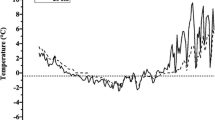Summary
The triggering of cryoprotectant synthesis was examined in the freeze tolerant wood frog,Rana sylvatica. A slow decrease in ambient temperature (1°C every 2 days) from 3° to −2.1 °C was used to search for a specific trigger temperature. None was found. Instead it was found that, despite subzero temperature, animals which remained in a supercooled unfrozen state had low blood glucose (1.66±0.44 μmol/ml) while those which had frozen had high blood glucose (181±16 μmol/ml). These results indicate that it is the initiation of ice nucleation, rather than a specific subzero temperature, which triggers cryoprotectant glucose synthesis. This was confirmed by monitoring the freezing curves for individual frogs with sampling of blood and tissues at various times relative to the initiation of nucleation (detected as an instantaneous temperature jump from −3 to −1°C). Animals sampled before nucleation had low blood and liver glucose contents and a low percentage of liver phosphorylase in thea form. Within 4 min of the initiation of freezing, however, blood glucose had jumped to 16 μmol/ml and liver glucose to 39.5 μmol/g wet weight. Glucose in both compartments continued to increase as the time of freezing increased correlated with an increase in liver phosphorylasea content from 47% before nucleation to 100% after 50 min of freezing. The results clearly demonstrate that freeze tolerant frogs have no anticipatory synthesis of cryoprotectant as a preparation for winter but rather can translate the initiation of extracellular ice formation into a signal which rapidly activates cryoprotectant production by liver.
Similar content being viewed by others
References
Danks HV (1978) Modes of seasonal adaptation in the insects. I. Winter survival. Can Ent 110:1167–1205
Duman JG, Horwath KL (1983) The role of hemolymph proteins in the cold tolerance of insects. Annu Rev Physiol 45:261–270
MacArthur DL, Dandy JWT (1982) Physiological aspects of overwintering in the boreal chorus frog (Pseudacris triseriata maculata). Comp Biochem Physiol 72A:137–141
Ring RA (1980) Insects and their cells. In: Ashwood-Smith MJ, Farrant J (eds) Low temperature preservation in medicine and biology. Pitman Medical Publishing, Tunbridge Wells, pp 187–217
Schmid WD (1982) Survival of frogs in low temperature. Science 215:697–698
Storey KB (1984) Freeze tolerance in the frogRana sylvatica. Experientia 40:1261–1262
Storey JM, Storey KB (1983) Regulation of cryoprotectant metabolism in the overwintering gall fly larva,Eurosta solidaginis: Temperature control of glycerol and sorbitol levels. J Comp Physiol 149:495–502
Storey JM, Storey KB (1985) Freeze tolerance in the gray tree frog,Hyla versicolor. Can J Zool (in press)
Storey KB, Storey JM, (1984) Biochemical adaptation for freezing tolerance in the wood frog,Rana sylvatica J Comp Physiol B 155:29–36
Author information
Authors and Affiliations
Rights and permissions
About this article
Cite this article
Storey, J.M., Storey, K.B. Triggering of cryoprotectant synthesis by the initiation of ice nucleation in the freeze tolerant frog,Rana sylvatica . J Comp Physiol B 156, 191–195 (1985). https://doi.org/10.1007/BF00695773
Accepted:
Issue Date:
DOI: https://doi.org/10.1007/BF00695773




